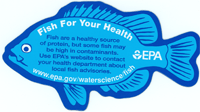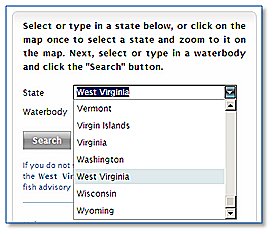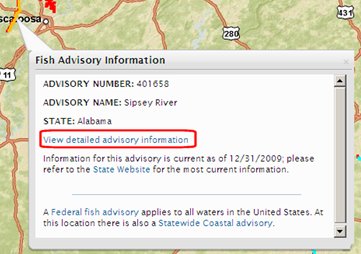Water: Fish Advisories
Fish Consumption Advisories - General Information
|
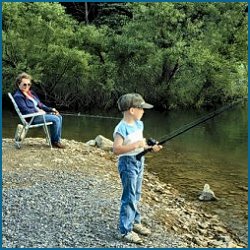 |
About Fish Advisories |
 |
Basic Information
Fish are an important part of a healthy diet. They are a lean, low-calorie source of protein. However, some fish caught in the nation's lakes, rivers, oceans, and estuaries may contain chemicals that could pose health risks. When contaminant levels are unsafe, consumption advisories may recommend that people limit or avoid eating certain species of fish caught in certain areas.
Most of the nation's waters contain fish that are safe to eat. However, all 50 states, the District of Columbia, the U.S. territories of American Samoa and Guam, and five Native American tribes (for simplicity, referred to here as "states") have fish consumption advisories in place to protect their residents from the potential health risks of eating contaminated fish caught in local waters.
What are fish advisories?
A fish consumption advisory is not a regulation. Rather it is a recommendation issued to help protect public health. These advisories may include recommendations to limit or avoid eating certain species of fish caught from specific water bodies or from water-body types (e.g., lakes, rivers or coastal waters) due to chemical contamination. An advisory may be issued for the general public, including recreational and subsistence fishers, or it may be issued specifically for sensitive populations, such as pregnant women, nursing mothers, and children. An advisory for a specific waterbody or water-body type may cover more than one affected fish species or chemical contaminant. Advisories apply to locally-caught fish and sometimes apply to fish purchased in stores and restaurants. You can find fish advisories by state at Advisories Where You Live.
What are safe eating guidelines?
Safe eating guidelines let people know when there are no limits on eating fish from specific waters or certain fish species. The EPA encourages states to issue safe eating guidelines when providing advisory information, to inform the public that fish from specific water bodies have been tested for chemical contaminants and that, based on those results, certain species of fish from those water bodies are safe to eat without consumption restrictions.
For what pollutants are the advisories issued?
Most advisories involve five primary contaminants: mercury, PCBs, chlordane, dioxins, and DDT. These chemical contaminants persist for long periods in sediments where bottom-dwelling animals accumulate and pass them up the food chain to fish. Levels of these contaminants may increase as they move up the food chain, so top predators in a food chain (such as largemouth bass or walleye) may have levels several orders of magnitude higher than the water.
What advice do the EPA and FDA provide about mercury in fish?
In June 2014, EPA and FDA released for review and comment an update to the 2004 advice contained in their jointly released document entitled “What You Need to Know about Mercury in Fish and Shellfish.” The 2004 advice targeted women who might become pregnant, women who are pregnant, nursing mothers, and young children. The proposed update makes the advice consistent with the Dietary Guidelines for Americans 2010.
Fish is an important part of a healthy diet, and women and young children in particular should include fish and shellfish in their diets. But nearly all fish and shellfish contain traces of mercury and, while this is not a health concern for most people, those that contain higher levels of mercury may harm an unborn baby or young child’s developing nervous system. The risks depend on the amount of fish eaten and the amount of mercury in the fish. Click here for more information on the mercury in fish consumption advisory.
Federal Consumption Advice
|
You will need Adobe Reader to view some of the files on this page. See EPA's PDF page to learn more.  |
Joint Federal Advisory for Mercury in Fish
Alternate translations of this brochure are available: |
Want to order hard copies of these publications? They're free!

Healthy Eating of the Fish you Catch
Should I Eat the Fish I Catch? This brochure is a guide to help you select and prepare fish that are low in chemical pollutants.
Note: This is a 4-fold document that can be viewed in its entirety online but must be printed on legal size (8 1/2" X 14") paper. It is available in the following languages:
- English (PDF) (161K)
- Spanish (PDF) (131K)
- Hmong (PDF) (145K)
- Korean (PDF) (324K)
- Vietnamese (PDF) (273K)
Our One Fish, Two Fish poster gives you easy to remember information about the amount of fish women of childbearing age and children can safely eat. Click the image to view a larger version of the "One Fish, Two Fish" poster (JPG image) (December 2006; 245K).

Fish Key Tags! Can't remember how many meals per week of fish to eat? Keep this information at your fingertips with this helpful fish keytag. Click here for a full-sized version of the key tag, front and back (PDF) (466K).

"Eat two meals per week of a variety of fish lower in mercury, such as: canned light tuna, catfish, pollack, salmon and shrimp."
Outreach to Health Care Providers
The EPA and the Agency for Toxic Substances and Disease Registry worked together to inform health professionals and their patients about the dangers of eating fish harvested from contaminated waters.
- Letters to Health Care Professionals/Providers
- Distributed in all states without fish consumption advisories (except Alaska) (PDF) (1 pg, 245K) (May 2001)
- Health Care Professionals (December 1998)
- Health Care Providers (December 1998)
- Distributed in all states with fish consumption advisories (PDF) (1 pg, 240K) (May 2001)
Advisories Where You Live |
 |
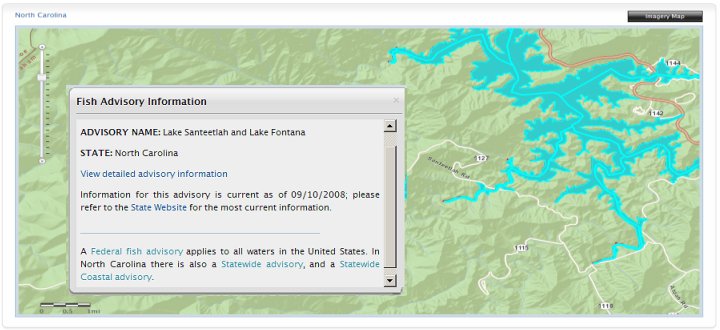 | ||
Introduction | ||
|
State and local environmental programs and departments of health issue fish consumption advisories for their waterbodies. Searching "Advisories Where You Live" is the fastest way to get fish advisory information on a state or local level. However, you can obtain more detailed fish advisory information by performing an advanced search of the NLFA database. To conduct an advanced search, go to the NLFA Technical Advisories Search. | ||
Learn about the fish where you live.
The Advisories Where you Live search provides historical data on fish advisories in the United States and its territories. EPA requests fish advisory data from the states, territories, and tribes and updates the NLFA database every 2 years. States may add new advisories or rescind advisories before this data appears in the NLFA database. Therefore, for the most current fish advisory and meal advice information for your state, please visit your state fish advisory website. |
||
Quick StartA drop-down search form with type-ahead functionality allows the user to find advisories for a specific waterbody.
OR |
|
Please note that only applicable statewide advisories will be visible after you select a state. Advisories on specific waterbodies, for that state only will be visible on the map after you complete your first search for a waterbody name (see instructions in step 2 below).
- Next, select or type in a waterbody name and click the "Search" button. Waterbody options are tailored to the state selected.
Note: Waterbody names are taken from GNIS/NHD databases and may not match the waterbody name assigned by the state. If you do not see your waterbody listed, please go directly to the state's website for the most current fish advisory information.
After you click "Search" the map will automatically zoom in to the chosen waterbody. If there is no advisory on that waterbody, a pop-up box will notify you. For waters shared between states (e.g., large rivers and lakes) you are encouraged to search for advisories in all states that border the waterbody.
View Advisory Details
|
View detailed information about a single advisory by clicking on it on the map and then clicking on the "View detailed advisory/tissue information" link. Getting HelpThe Help button ( View User Guide |
|
Go to Maps & Searches
- Advisories Where You Live
- Fish Advisories - Advanced Search and Mapping
- Fish Tissue Data - Advanced Search and Mapping
Contacts
Visit the contacts page to find links to federal, state and tribal contacts and fish advisory programs.
National Listing of Fish Advisories Database
The National Listing of Fish Advisories (NLFA) database includes all available information describing state-, tribal-, and federally-issued fish consumption advisories in the United States for the 50 states, the District of Columbia, and U.S. territories; and historical data for the 12 provinces and territories in Canada . Since 1993, the EPA has made the NLFA available to let people know about locally-issued fish advisories and safe eating guidelines. The database contains information provided to EPA by the states, territories, and tribes.
Release of 2011 Data
- General Fact Sheet (December 2013)
- Technical Fact Sheet | Technical Fact Sheet Print Version (PDF) (8 pp, 1.6MB; EPA 820-F-13-058)
- Questions & Answers
- National Maps and Graphics (PDF) (11 pp, 1.3MB)
NLFA Database
The inclusion of information provided by states, tribes, territories and Canada does not imply any official EPA endorsement. Furthermore, EPA does not accept any responsibility for the data provided by these entities or guarantee the validity of this data.
- Advisories Where You Live
- Fish Advisories - Advanced Search and Mapping
- Fish Tissue Data - Advanced Search and Mapping
NLFA Newsletter


